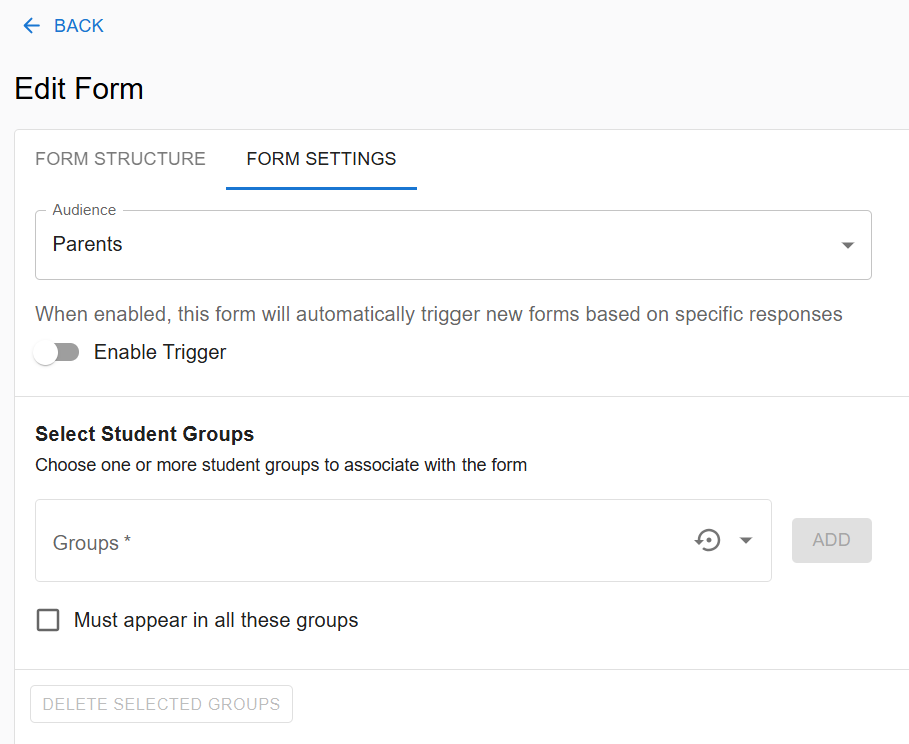Overview #
Located at the top-left of the page, the “Create New Form” button allows administrators to start the process of creating a new form. Clicking this button opens a form builder interface where users can define the form fields, group, type, and other details.

Step-by-Step Instructions #
Form Template Selection #
Form Template Dropdown: Begin by selecting a template from the “Form Template” dropdown menu. This template serves as the foundation for your form.
Options might include pre-designed templates like “Template – Empty Form” or specific form templates tailored for common use cases.
Form Details #
Form Name: Enter a descriptive name for your form in the “Form Name” field. This name will be displayed in the form list and used to identify the form.
Expiration Date: Use the calendar icon to set an expiration date for the form. This date determines when the form will no longer be available for submissions.
Remind Interval: Set a reminder interval in hours. This will send auto reminders to recipients who haven’t completed the form. Entering “0” disables reminders.
Access Level: Choose the access level for your form. Options include:
Public: The form is accessible to anyone with the link.
Private: The form is only accessible to specified recipients.
Categories: Assign a category to your form from the dropdown menu. This helps in organising and filtering forms later.
Form Builder #
Form Elements: Use the available form elements to design your form. Click on any element to add it to your form. Available elements include:
Notes: Add a section for descriptive text or instructions.
Attachment: Allow users to upload files.
Image: Insert an image into the form.
Checkbox: Add checkboxes for multiple selections.
Dropdown: Provide a dropdown list for single selection.
Multiple Choice: Add multiple choice questions.
Signature: Include a signature field for digital signatures.
Single Choice: Add radio buttons for single selection.
Single Line: Insert a single line text input.
Textbox: Add a multi-line text input.
Tick Box Grid: Provide a grid of checkboxes for multiple selections.
Multiple Choice Grid: Add a grid of radio buttons for single selections per row.
Linear Scale: Insert a scale for rating or other linear responses.
Preview and Save:
Preview: Click the “PREVIEW” link on the right side of the form builder to see how your form will appear to users.
Save Form: Once you have completed designing your form, click the “SAVE FORM” button at the bottom right to save your form. Ensure all required fields are filled out before saving.
Define Recipients #
After saving the form setup, proceed to the next step to define recipients. This step ensures that the right audience receives or has access to the form. There are four types of assignments.
- Parents (for child completion) – forms to be completed by the parent(s) on behalf of the child
- Previous School (this information is captured from the Application Form)
- External Users
- Students
Each of these form types can also be used as a Conditional Trigger Form, where different forms are sent to the recipient depending on the response to another form.
Must appear in all these groups – when you select this checkbox, the form will only be assigned to students who are members of all the groups that you have selected in the assignments section. If a student is only a member of some (but not all) of the selected groups, the form will not be assigned to them.
Parents #
allows the form creator to assign groups of students to a form, or assign students individually. The form will be sent to the contacts of selected students who have parental responsibility.

Previous School #
Allows the user to assign the form to the student or group of students’ previous school. This type of form will be sent to the feeder school directly from the information provided by the parent on the application form.

External Users #
Allows the user to assign the form to up to five external users. This functionality can also be used to add staff members to workflow forms, as staff profiles are not yet integrated with Admicity (this feature is coming soon). This is useful for parts of the admissions workflow that require input from school staff, and when organising school trips that require a staff member to complete a risk assessment of staff volunteer form.

Students #
Allows the user to assign the form to students or groups of students. This type of form will be sent to the student directly if he/she is registered in the system.

Adding Trigger Settings #
These are used to connect a form to the response of a previous form in order to create different branches of a workflow. The example below is a trigger form linked to the YES response of the decision of whether or not an applicant is Suitable to Board. A different trigger form will be linked to the NO response to this question.

Go Live (Optional) #
In the final step, you can choose to make the form live, making it available for submissions immediately.
Once the form is activated the notification email is sent to all assigned persons. Please note that the system uses text from the first component on the form to display in the recipient’s email notification, if the component type is Notes. Then, the email notification will be:
